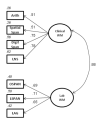A Comparison of Laboratory and Clinical Working Memory Tests and Their Prediction of Fluid Intelligence
- PMID: 20161647
- PMCID: PMC2818304
- DOI: 10.1016/j.intell.2008.11.005
A Comparison of Laboratory and Clinical Working Memory Tests and Their Prediction of Fluid Intelligence
Abstract
The working memory (WM) construct is conceptualized similarly across domains of psychology, yet the methods used to measure WM function vary widely. The present study examined the relationship between WM measures used in the laboratory and those used in applied settings. A large sample of undergraduates completed three laboratory-based WM measures (operation span, listening span, and n-back), as well as the WM subtests from the Wechsler Adult Intelligence Scale-III and the Wechsler Memory Scale-III. Performance on all of the WM subtests of the clinical batteries shared positive correlations with the lab measures; however, the Arithmetic and Spatial Span subtests shared lower correlations than the other WM tests. Factor analyses revealed that a factor comprising scores from the three lab WM measures and the clinical subtest, Letter-Number Sequencing (LNS), provided the best measurement of WM. Additionally, a latent variable approach was taken using fluid intelligence as a criterion construct to further discriminate between the WM tests. The results revealed that the lab measures, along with the LNS task, were the best predictors of fluid abilities.
Figures



Similar articles
-
Measuring Working Memory With Digit Span and the Letter-Number Sequencing Subtests From the WAIS-IV: Too Low Manipulation Load and Risk for Underestimating Modality Effects.Appl Neuropsychol Adult. 2015;22(6):445-51. doi: 10.1080/23279095.2014.992069. Epub 2015 Apr 24. Appl Neuropsychol Adult. 2015. PMID: 25910198
-
Evaluating working memory: Comparing change-detection tasks and Wechsler working memory subtests in school-age children.J Clin Exp Neuropsychol. 2017 Sep;39(7):636-645. doi: 10.1080/13803395.2016.1252726. Epub 2016 Nov 13. J Clin Exp Neuropsychol. 2017. PMID: 27841096
-
Can we improve the clinical assessment of working memory? An evaluation of the Wechsler Adult Intelligence Scale-Third Edition using a working memory criterion construct.J Clin Exp Neuropsychol. 2010 Mar;32(3):315-23. doi: 10.1080/13803390903032529. Epub 2009 Aug 5. J Clin Exp Neuropsychol. 2010. PMID: 19657913 Free PMC article.
-
A Latent Factor Analysis of Working Memory Measures Using Large-Scale Data.Front Psychol. 2017 Jun 28;8:1062. doi: 10.3389/fpsyg.2017.01062. eCollection 2017. Front Psychol. 2017. PMID: 28701976 Free PMC article.
-
The Relationship between Working Memory and Arithmetic in Primary School Children: A Meta-Analysis.Brain Sci. 2022 Dec 22;13(1):22. doi: 10.3390/brainsci13010022. Brain Sci. 2022. PMID: 36672004 Free PMC article. Review.
Cited by
-
Working memory's workload capacity.Mem Cognit. 2015 Oct;43(7):973-89. doi: 10.3758/s13421-015-0526-2. Mem Cognit. 2015. PMID: 25962602
-
Age differences in emotion regulation effort: Pupil response distinguishes reappraisal and distraction for older but not younger adults.Psychol Aging. 2018 Mar;33(2):338-349. doi: 10.1037/pag0000227. Psychol Aging. 2018. PMID: 29658751 Free PMC article.
-
Clinical utility of the N-back task in functional neuroimaging studies of working memory.J Clin Exp Neuropsychol. 2014;36(8):875-86. doi: 10.1080/13803395.2014.953039. Epub 2014 Sep 25. J Clin Exp Neuropsychol. 2014. PMID: 25252868 Free PMC article.
-
How do we measure attention? Using factor analysis to establish construct validity of neuropsychological tests.Cogn Res Princ Implic. 2021 Jul 22;6(1):51. doi: 10.1186/s41235-021-00313-1. Cogn Res Princ Implic. 2021. PMID: 34292418 Free PMC article.
-
Relationship of Working Memory, Processing Speed, and Fluid Reasoning in Psychiatric Patients.Psychiatry Investig. 2018 Dec;15(12):1154-1161. doi: 10.30773/pi.2018.10.10.2. Epub 2018 Nov 26. Psychiatry Investig. 2018. PMID: 30466206 Free PMC article.
References
-
- Ackerman PL, Beier ME, Boyle MO. Individual differences in working memory within a monological network of cognitive and perceptual speed abilities. Journal of Experimental Psychology: General. 2002;131:567–589. - PubMed
-
- Ackerman PL, Beier ME, Boyle MO. Working memory and Intelligence: the same or different constructs? Psychological Bulletin. 2005;31:30–60. - PubMed
-
- Ashcraft MH, Kirk EP. The relationship between working memory, math anxiety and performance. Journal of Experimental Psychology: General. 2001;130:224–237. - PubMed
-
- Baddeley AD. Working memory thought and action. Oxford University Press; Oxford, England: 2007.
-
- Baddeley AD, Gathercole SE, Papagno C. The phonological loop as a language learning device. Psychological Review. 1998;105:158–173. - PubMed
Grants and funding
LinkOut - more resources
Full Text Sources
Miscellaneous
